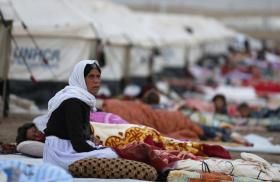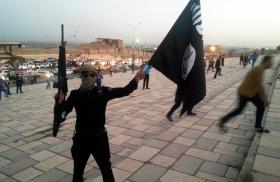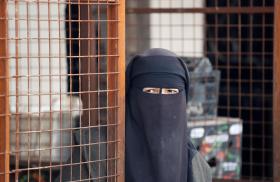

Part of a series: Counterterrorism Lecture Series
or see Part 1: U.S. Efforts against Terrorism Financing: A View from the Private Sector
A look at the evolving shape of the global fight against terrorism.
On October 24, 2008, Assistant Secretary of Defense Michael Vickers addressed a Policy Forum luncheon at The Washington Institute as part of the Institute's 2007-2008 counterterrorism lecture series. The U.S. Senate confirmed Mr. Vickers as assistant secretary of defense (special operations/low-intensity conflict and interdependent capabilities) on July 23, 2007. The following is a rapporteur's summary of his remarks.
Read a complete transcript of this event.
Although much work still remains on the counterterrorism front, the past seven years have seen notable achievements. The Philippines and the area of Southeast Asia referred to as the "terrorist transit triangle" have seen considerable success against Abu Sayyaf and Jemaah Islamiyah. In the Middle East, the tide turned against al-Qaeda on the Arabian Peninsula in 2003, and al-Qaeda in Iraq is now only "a whisper of what it used to be." Moreover, although there have been many plots, no attacks have occurred on the U.S. homeland since September 11, 2001.
The threat, however, remains significant. Al-Qaeda has demonstrated an ability to regenerate, and its ambitions remain high. The group aims to catalyze an Islamist insurgency, break up and prevent the formation of international coalitions arrayed against it, exhaust and expel the West from Muslim lands, overthrow "illegitimate states," establish a caliphate, and transform the international balance of power in favor of this new Islamic polity.
In Iraq, the situation has improved, but General Petraeus and others have pointed out that the durability of the past year's dramatic change is difficult to measure, though the signs are pointing in the right direction. In Afghanistan, the insurgency has intensified over the past two years, and the international community faces a growing challenge to prevent the country from becoming a safe haven for terrorists and a source of instability.
The tribal areas of western Pakistan remain the most significant strategic threat, and the problem has escalated over the past decade. In late 2001 al-Qaeda's senior leaders fled Afghanistan after the successful U.S. operation there and managed to align themselves with local Pakistani groups in this unsettled region. These groups have become more militant as a result and now present an internal threat to Pakistan's government; in the past year, Osama bin Laden and Ayman al-Zawahiri have declared open war on the country. Not only is this threat serious for Pakistan, it poses an immense challenge to international strategy and stability in the region and beyond.
Furthermore, the United States faces challenges in the Horn of Africa, Somalia, Yemen, the Levant, and the Maghreb -- all areas that al-Qaeda targets strategically. The threat remains global, emanating not just from traditional Muslim lands but also from the United Kingdom and other parts of Western Europe. In fact, we have seen just as many or more threats emerging from Europe over the past decade as we have seen emanating from the greater Middle East.
The long-term strategic challenge of the war on terror is dealing with a threat that has spread across the globe to some sixty countries. We can take either a direct approach, applying power ourselves as primary actors, or an indirect approach, working through others whom we advise, train, and enable. A clandestine component is also imperative, as this is primarily an intelligence war, or a "war in the shadows." Our intelligence disciplines are therefore essential -- particularly covert action, which was the decisive instrument of the Cold War and remains critical to the war on terror today.
Above all, the critical operational instrument of this war is what we describe as a global counterterrorism network. This network's purpose is to create a persistent, ubiquitous presence in many countries that prevents adversaries from gaining traction and gradually smothers them over time. Ultimately, it takes a network to defeat a network. It is not enough to have a strong partner in one or more countries; we must be stronger than our adversaries everywhere. The principal operational element of this network is the intelligence community, which gives us our global reach and allows us to move at the speed of war.
In particular, the national clandestine service of the Central Intelligence Agency, in conjunction with U.S. Special Forces and the security apparatuses of our partners around the world, is central in this battle. Special Operations Forces have grown tremendously in the Department of Defense in recent years. By the end of the decade, the forces will be twice as large (reaching upwards of 64,000 in terms of total manpower) than they were at its outset, with more than double the original budget. In addition, more senior leaders will have special-operations backgrounds.
The core of U.S. Special Forces consists of approximately 15,000 ground operators, ranging from Army Special Forces and Green Berets to Rangers, Seals, Marine Corps Special Operations, and other classified units. Each of these elements has increased its capacity by a third since 2001, constituting the largest growth in Special Operations history. These forces are present in sixty countries around the globe, with more than 80 percent concentrated in the greater Middle East, the U.S. Central Command's area of responsibility, particularly Iraq and Afghanistan. Thus, we are expanding our force significantly to achieve broader global coverage.
These forces have invented a new way to fight the war on terror, waging it from an operational perspective and taking a proactive and sustained approach to counterterrorism. We now have intelligence-driven operations, with new tactics, techniques, and procedures -- the cumulative effect of which will enable us to take down a network over time.
Gaps, however, still exist in the areas of intelligence, surveillance, and reconnaissance. We need to increase capacity in civil affairs and psychological operations, and we are also taking steps to acquire foreign-language expertise, in part by recruiting foreign-born operators. Additional organizational reform may also be in order, such as greater integration and consolidation, as exemplified by the Department of Homeland Security. We are looking at alternative command arrangements within the Department of Defense as well as mainstreaming Special Operations officers into senior leadership positions. We have the necessary institutions, but we must now focus on getting the right people and ensure that that they receive the necessary resources and authority.
Some of our current capabilities, capacities, and relationships predate the September 11 attacks, some have been significantly expanded since then, and others will reach the projected end state by the end of the next administration. There will likely be a need for more integration as we go forward, and we must operate simultaneously in countries with whom we are not at war. Thus, partner development and partner alignment remain critical issues, making diplomacy essential to achieving our goals. The pieces are gradually coming into place as we gain more experience and enhance our ability to build and develop a far more capable network. We are well on our way to building a global counterterrorism network -- the critical instrument for keeping America safe through the next decade and beyond.
This rapporteur's summary was prepared by Sana Mahmood.





